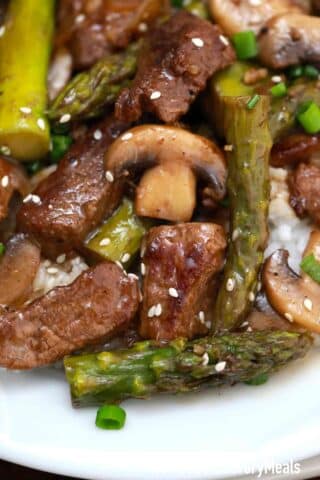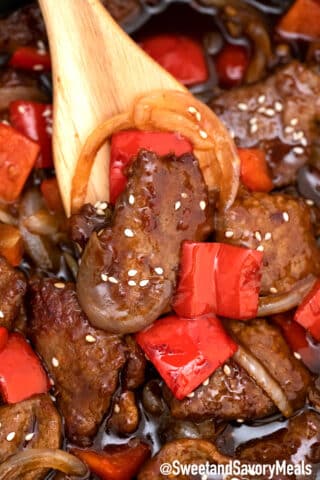Mongolian Beef Recipe
I have a recipe that beats the original restaurant dish and can be prepared quicker than ordering takeout. I know this sounds too good to be true, but my PF Chang’s Mongolian Beef copycat recipe takes just 30 minutes to make. This effortless dinner is my go-to solution when I crave bold Asian flavors without the hassle of going to a restaurant or ordering takeout.
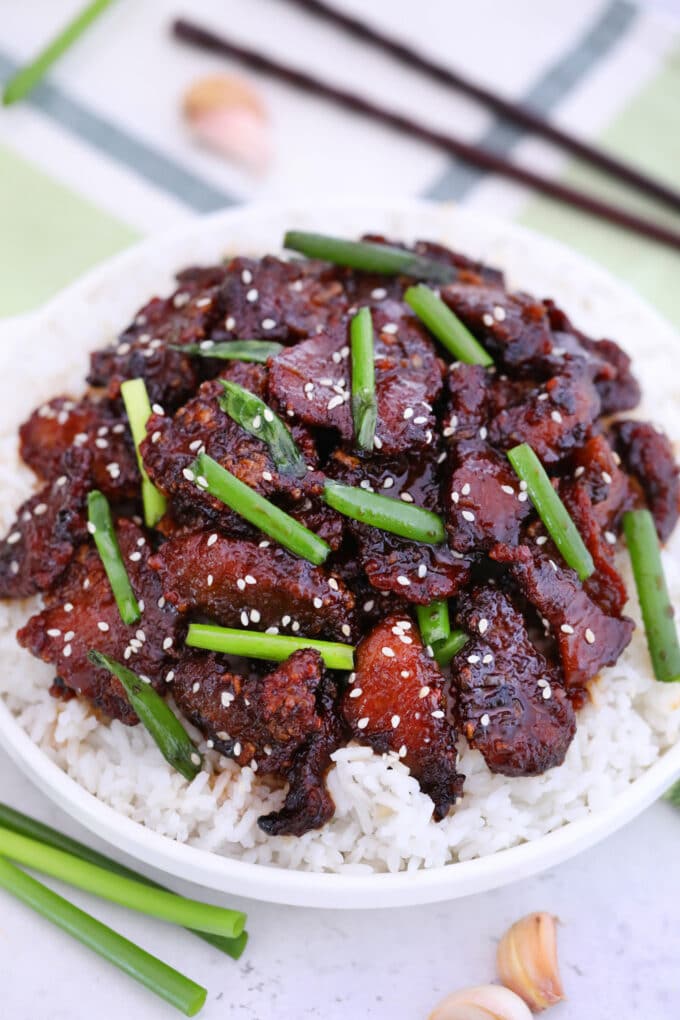
I am a huge fan of Asian recipes and have even started recreating all the Panda Express recipes. As much as dining out is fun, I don’t always have the energy, and let’s be honest, my budget has started to suffer, too. Recreating the recipes at home has been a genial idea, like this crispy orange chicken that my family absolutely adores or these honey walnut shrimp, one of my favorite Asian dishes ever!
Table of contents
This fuss-free recipe has been a staple in my kitchen from the moment I tried it. It’s especially ideal for busy weeknights, when I have limited time but still crave a homemade dinner. Made with simple ingredients, the beef is cooked to crispy perfection and coated in a rich, sweet, and savory sauce, just like the one you get at PF Chang’s but for a fraction of the cost. This is a restaurant-quality dish that you can easily make at home.
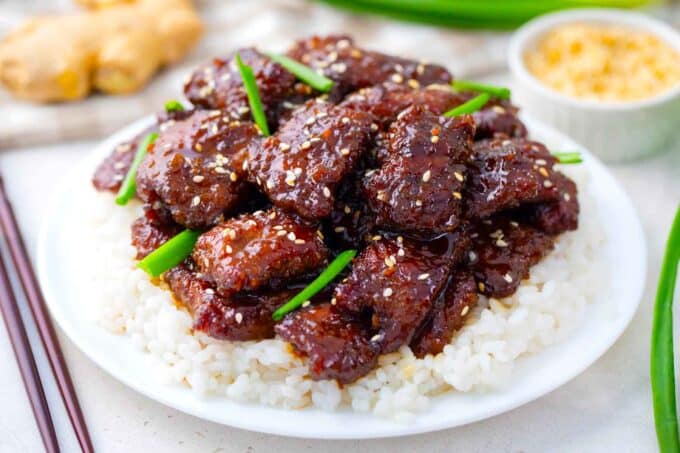
Why you will love this recipe
- It’s better than the restaurant: When I make it myself, I can add as much seasoning and sauce as I want, and it is cooked to perfection. Also, you can make it for a fraction of the cost!
- I save a lot of money: I can feed the whole family for less than the price of one plate at PF Chang’s.
- No additives: I use organic ingredients, and when making it at home, you do not add MSG or unnecessary ingredients. The only thing I add is fresh, delicious flavor.
- I can freeze the leftovers: Because I like to make extras, I can separate the leftovers into small freezer bags or meal plan containers for future meals.
What you will need
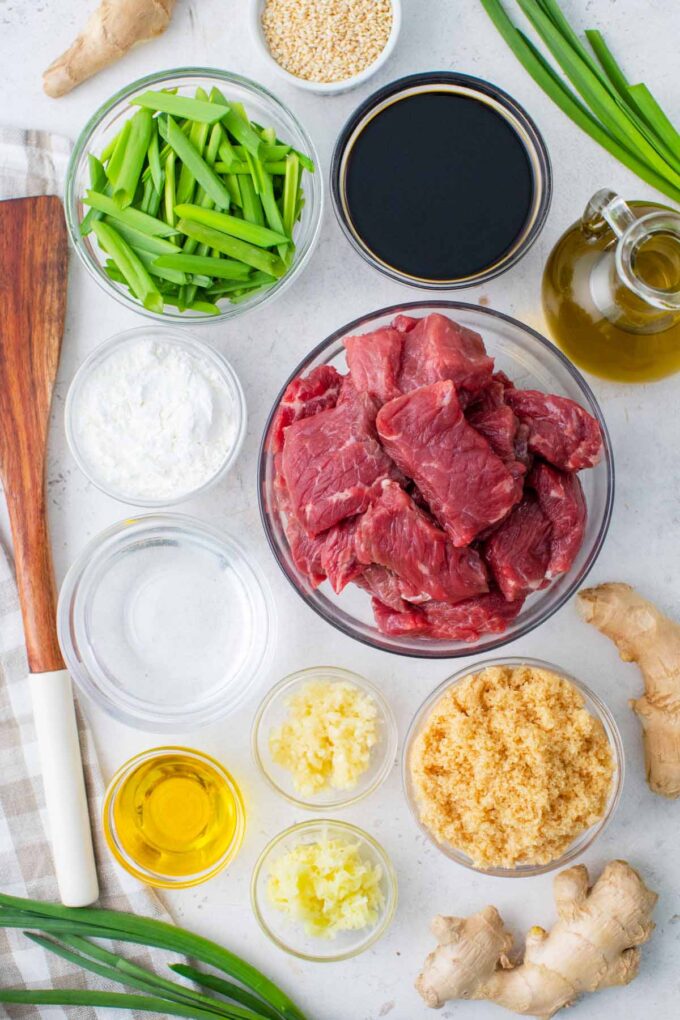
- Main ingredients: I use organic flank steak, thinly sliced against the grain. I tender it with cornstarch before cooking it in vegetable oil.
- For the sauce, it’s just soy sauce, sesame oil, and dark brown sugar mixed with minced garlic and fresh ginger. I add some chopped green onions and sesame seeds right before serving so they are still crunchy. It’s a simple but fresh and bold-tasting sauce.
How to make
Coat: First, I mix the beef with the cornstarch in a bowl until it is coated.

Fry: I fry it in vegetable oil in a large saucepan for about two minutes until brown. Then, I drain it on a paper towel and clean the skillet.

Make the sauce: Next, I heat the sesame oil, ginger, and garlic in a medium saucepan for 30 seconds on medium low before whisking in the soy sauce, brown sugar, and ½ cup of water. I let it cook until it is slightly thickened, whisking occasionally, for about five minutes.
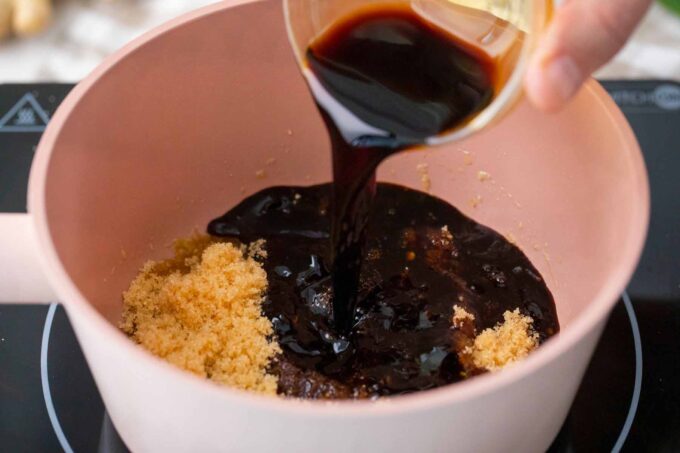
Add the beef and serve: Now, I add the beef back to the clean skillet and pour in the thickened sauce, heating it on medium for about two minutes, until it thickens.

Serve: I garnish the dish with green onions and sesame seeds before serving.
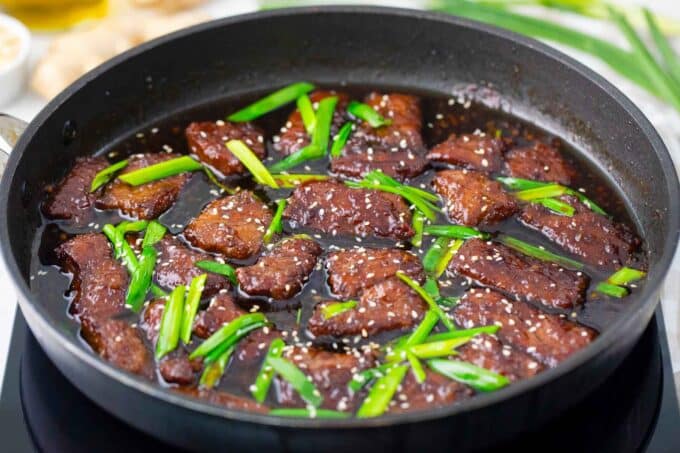
Expert tip
How to get the most tender beef
The most crucial step is getting the correct high-quality cut of beef. I highly recommend organic meat because it has fewer additives. I use flank steak for this recipe because it is long and thin, with a prominent grain, which makes it easier to cut. The next step in getting tender beef is slicing it against the grain.
The beef has to be cut into thin slices, about ¼ inch thick, against the grain, for tender pieces. Then, I toss it with baking soda or cornstarch in a freezer bag before frying it over high heat. The baking soda raises the pH of the meat to make it more tender. Finally, cooking it quickly and not overcrowding it will keep the meat tender.
More tips to consider
- I like to put the steak into the freezer for 15 to 20 minutes before, making it easier to slice.
- Do not try to substitute flour for cornstarch. Flour does not have the pH needed to tenderize the meat.
- Serve the beef immediately after mixing it in the sauce so it doesn’t get soggy.
- Add the green onions and sesame seeds at the end so they are crispy.
- Use fresh ginger and garlic for the best flavor.
- The sauce can also be made ahead of time and stored.
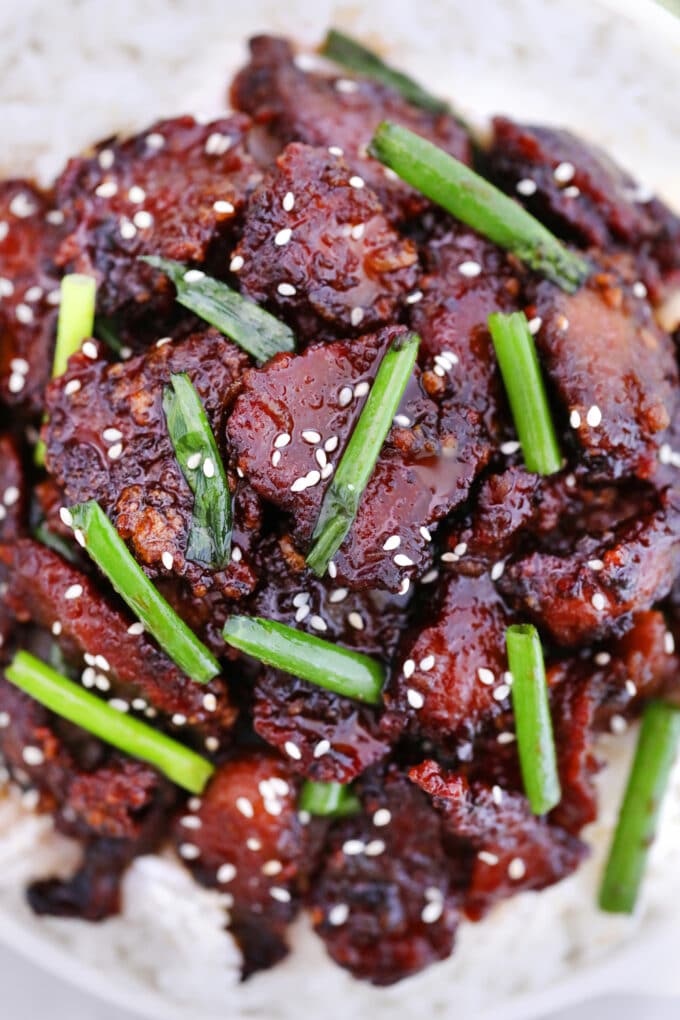
Recipe variations and add-ins:
- Different meat: I sometimes use chicken, turkey, or pork instead of beef for this dish. I especially like the chicken, which you’ll find in this Mongolian chicken recipe.
- Extra spicy: My friends like it when I add a chopped red chile and 1/4 teaspoon red chili powder to this dish to give it extra heat.
- Add vegetables: To make this a full meal, I like to add some broccoli spears, cauliflower florets, and chopped carrots.
- More crunch: Sometimes, I add chopped peanuts to make this dish crunchier. I like the salty flavor and extra texture.
- Add fruit: To make this dish sweet and savory, add pineapple tidbits or chopped apricots. The sweet flavors complement the rich beefy taste.

Serving suggestions:
I serve my Mongolian beef with white or brown rice. I have an easy recipe for cooking perfect rice in the Instant Pot for fluffy, soft rice in minutes. I make my chicken egg rolls and this hot and sour soup for an appetizer. Soba noodles are also a wonderful Asian side dish, especially with roasted bok choy. They pair well together, taste fantastic, and are easy to make.
For dessert, my blueberry zucchini poke cake will satisfy everyone’s sweet tooth. It is moist, creamy, full of juicy blueberries, and topped with rich cream cheese frosting. The best part? It can be made in advance. I also like mango desserts when I serve Asian dishes. This mango chia pudding is sweet and creamy and takes minutes to fix, while this mango mousse cake is more sophisticated but worth it!
How to store leftovers:
- Reheating: For the best results, I reheat my Mongolian beef in a skillet on medium-high heat for several minutes until it is heated through. It can also be reheated in the microwave but may be chewy.
- Refrigerate: Put leftovers in a sealed container and refrigerate for up to four days.
- Freezing: To keep them longer, I pack mine in freezer bags, which I can store flat for several months.
- Defrost: To thaw, I place frozen leftovers in the fridge overnight.
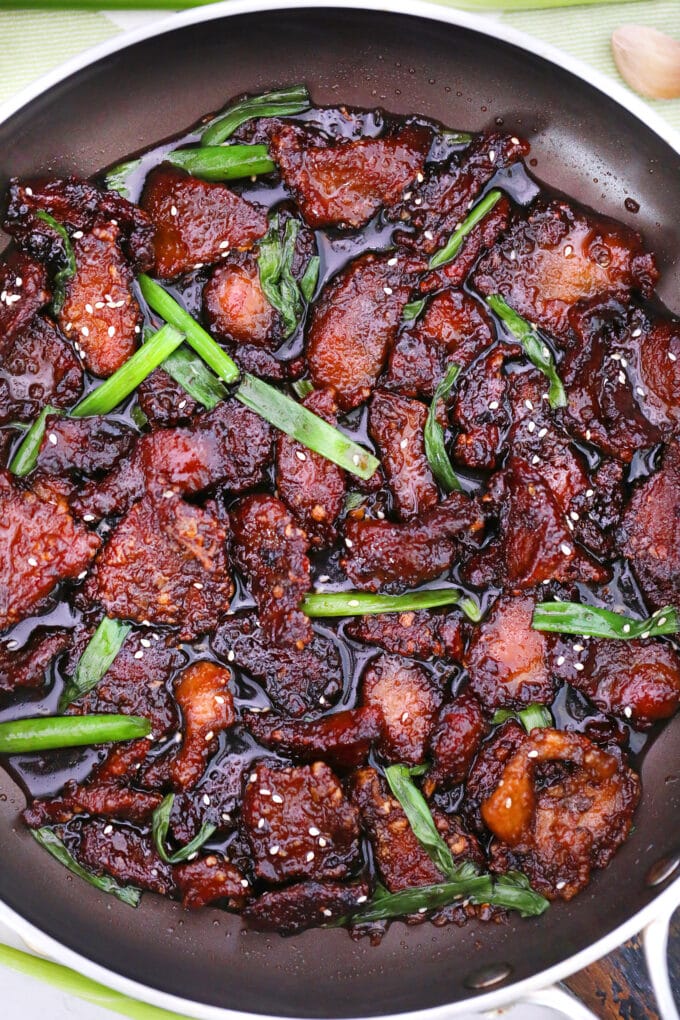
Frequently Asked Questions
It could be that it was cut too thick. I cut mine about ¼ inch thick or thinner. It should also be cut against the grain. Find the direction of the muscle fibers. These will be faint lines running across the meat. Then, cut the beef across these lines. This breaks down the long muscle fibers, making shorter pieces easier to chew. Also, be sure to get flank steak or another cut of beef that is good for this recipe.
For the best affordable option that is very similar, try the skirt steak. It has a very beefy taste but is tough, so I recommend marinating it for several hours and slicing it very thin. Sirloin is a nice alternative choice for flank steak as well. It is also less expensive but still tender when cut properly. Another great choice is the ribeye, which is extra tender. However, it has much more fat, making it harder to slice into thin pieces. It also creates a lot of grease.
Why did my beef lose its crispiness?
After taking all that time to soften the beef and then fry it to a perfect crispiness, the last thing I want is for it to get soggy. That is why it is essential not to leave it in the sauce too long after it is cooked. Letting it sit in the sauce will make it soft. Like any other crispy food, if it stays in liquid, it will absorb the juices and get soggy, so toss it in the sauce for a couple of minutes before serving it.
I always suggest using low-sodium soy sauce in my recipes because regular soy sauce adds a lot of salty flavor. Even the low-sodium version tastes salty. I would taste it before adding it to the sauce to see if it is too salty and maybe use a different brand. Do not add salt to the recipe unless you’ve tasted it and feel it needs some, even when cooking the beef. Add more sugar to help balance the saltiness if needed.
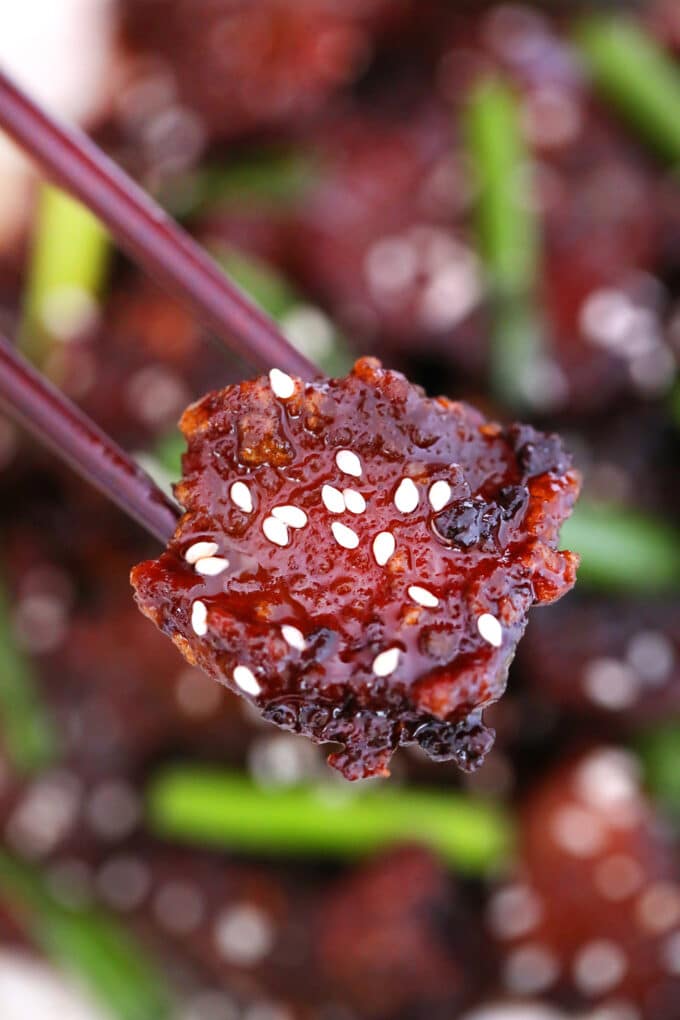
More Asian must-try recipes:
Loved this recipe? I’d love to hear from you! 💛 Leave a 5-star rating ⭐️ in the recipe card below and share your thoughts in the comments – I read and appreciate every single one!
Let’s stay connected! Follow me on Facebook, Instagram, Pinterest, and YouTube for more delicious, sweet and savory recipes. Have a question? Ask in the comments, and I’ll be happy to help! 😊 with love Catalina!
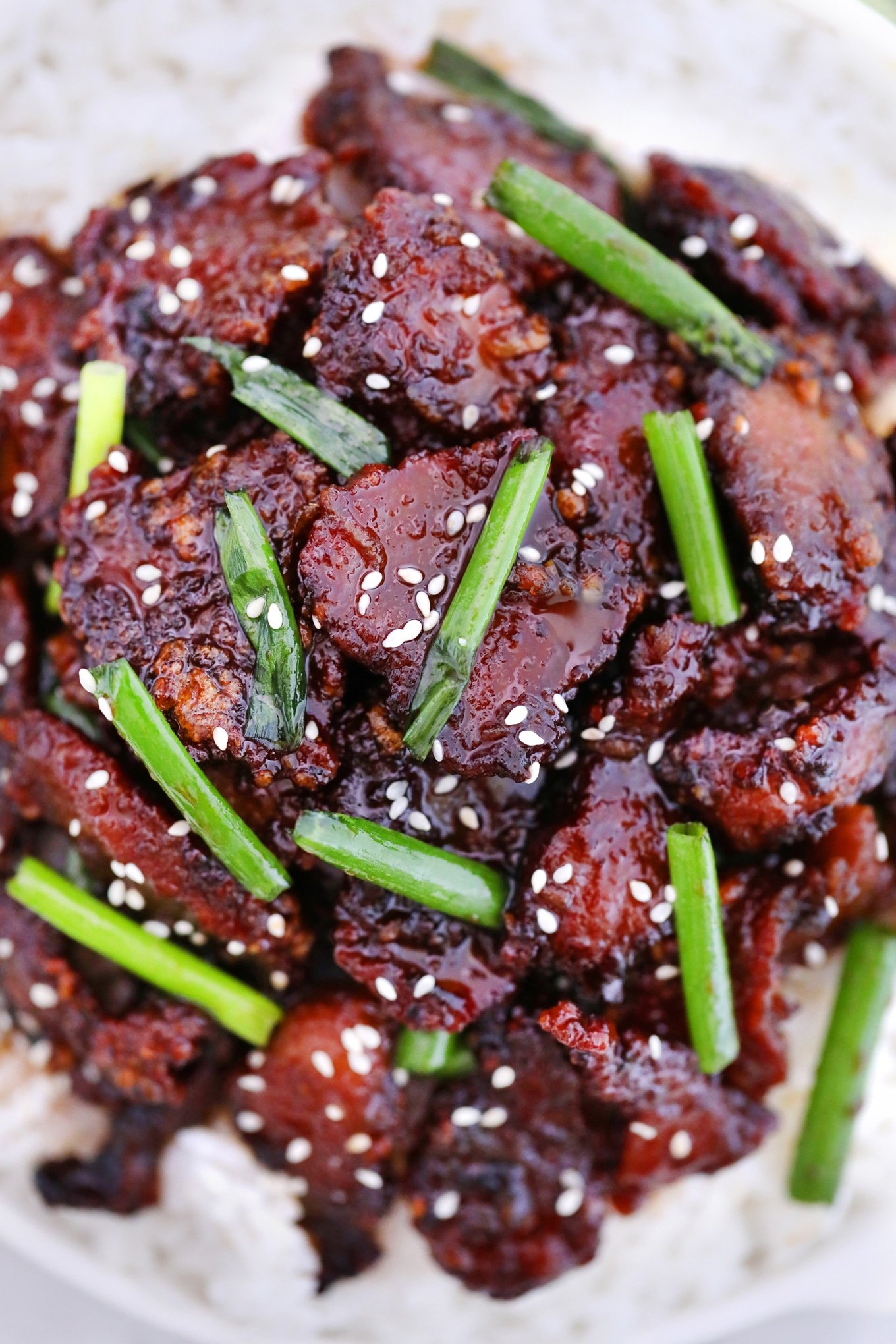
PF Chang’s Mongolian Beef Copycat
Ingredients
- 1 pound flank steak thinly sliced across the grain
- 1/4 cup cornstarch
- 1 cup vegetable oil
- 2 green onions thinly sliced on diagonal into 1 inch pieces
Sauce:
- 1/2 cup soy sauce
- 1/2 cup dark brown sugar
- 1/2 cup water
- 1 tablespoon minced garlic
- 1 tablespoon fresh ginger minced
- 2 teaspoons sesame oil or vegetable oil
Optional:
- 1 teaspoon sesame seeds
Instructions
Prepare the Beef:
- Add the sliced flank steak to a large bowl and mix with the cornstarch until the cornstarch is evenly distributed.
- Heat 1 cup of vegetable oil in a large saucepan. Once hot, add the beef and fry until browned and cooked through, about 1-2 minutes. Stir the meat around a little so that it cooks evenly. Transfer the beef to a paper towel-lined plate and discard the oil from the skillet.
Make the Sauce:
- In a medium saucepan over low/medium heat, add the oil, followed by the garlic and ginger. Cook and stir for 30 seconds, then whisk in the brown sugar, soy sauce, and water. Cook until slightly thickened, about 5-10 minutes. Set aside.
Add Beef:
- Add beef back to the skillet with the sauce mixture and cook over medium heat until the sauce thickens, about 2-3 minutes. Stir in green onions.
- Garnish with sesame seeds (optional). Serve immediately over rice.
Video
Notes
How to get the most tender beef
The most crucial step is getting the correct high-quality cut of beef. I highly recommend organic meat because it has fewer additives. I use flank steak for this recipe because it is long and thin, with a prominent grain, which makes it easier to cut. The next step in getting tender beef is slicing it against the grain. The beef has to be cut into thin slices, about ¼ inch thick, against the grain, for tender pieces. Then, I toss it with baking soda or cornstarch in a freezer bag before frying it over high heat. The baking soda raises the pH of the meat to make it more tender. Finally, cooking it quickly and not overcrowding it will keep the meat tender.More tips to consider
- I like to put the steak into the freezer for 15 to 20 minutes before, making it easier to slice.
- Do not try to substitute flour for cornstarch. Flour does not have the pH needed to tenderize the meat.
- Serve the beef immediately after mixing it in the sauce so it doesn’t get soggy.
- Add the green onions and sesame seeds at the end so they are crispy.
- Use fresh ginger and garlic for the best flavor.
- The sauce can also be made ahead of time and stored.

